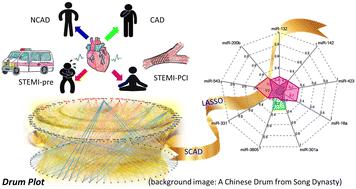Our official English website, www.x-mol.net, welcomes your
feedback! (Note: you will need to create a separate account there.)
Towards real-time myocardial infarction diagnosis: a convergence of machine learning and ion-exchange membrane technologies leveraging miRNA signatures
Lab on a Chip ( IF 6.1 ) Pub Date : 2024-10-04 , DOI: 10.1039/d4lc00640b Xiang Ren, Ruyu Zhou, George Ronan, S. Gulberk Ozcebe, Jiaying Ji, Satyajyoti Senapati, Keith L. March, Eileen Handberg, David Anderson, Carl J. Pepine, Hsueh-Chia Chang, Fang Liu, Pinar Zorlutuna
Lab on a Chip ( IF 6.1 ) Pub Date : 2024-10-04 , DOI: 10.1039/d4lc00640b Xiang Ren, Ruyu Zhou, George Ronan, S. Gulberk Ozcebe, Jiaying Ji, Satyajyoti Senapati, Keith L. March, Eileen Handberg, David Anderson, Carl J. Pepine, Hsueh-Chia Chang, Fang Liu, Pinar Zorlutuna

|
Rapid diagnosis of acute myocardial infarction (AMI) is crucial for optimal patient management. Accurate diagnosis and time of onset of an acute event can influence treatment plans, such as percutaneous coronary intervention (PCI). PCI is most beneficial within 3 hours of AMI onset. MicroRNAs (miRNAs) are promising biomarkers, with potential of early AMI diagnosis, since they are released before cell death and subsequent release of larger molecules [e.g., cardiac troponins (cTn)], and have greater sensitivity and stability in plasma versus cTn regardless of timing of AMI onset. However, miRNA-based AMI diagnosis can result in false positives due to miRNA content overlap between AMI and stable coronary artery disease (CAD). Accordingly, we explored the possibility of using a miRNA profile, rather than a single miRNA, to distinguish between CAD and AMI, as well as different stages following AMI onset. First we screened a library of 800 miRNA using plasma samples from 4 patient cohorts; no known CAD, CAD, ST-segment elevation myocardial infarction (STEMI) and STEMI followed by PCI, using Nanostring miRNA profiling technology. From this screening, based on machine learning SCAD and Lasso algorithms, we identified 9 biomarkers (miR-200b, miR-543, miR-331, miR-3605, miR-301a, miR-18a, miR-423, miR-142, and miR-132) that were differentially expressed in CAD, STEMI and STEMI-PCI and explored them to identify a miRNA profile for rapid and accurate AMI diagnosis. These 9 miRNAs were selected as the most frequently identified targets by SCAD and Lasso, as indicated in the “drum-plot” model in the machine learning approach. We used age-matched patient samples to validate selected 9 miRNA biomarkers using a multiplexed ion-exchange membrane-based miRNA sensor platform, which measures specific miRNAs, and cTn as a control, simultaneously as a point-of-care device. Findings from this study will inform timely and accurate diagnosis of AMI and its stages, which are essential for effective management and optimal patient outcomes.
中文翻译:

迈向实时心肌梗死诊断:机器学习和利用 miRNA 特征的离子交换膜技术的融合
急性心肌梗死 (AMI) 的快速诊断对于最佳患者管理至关重要。急性事件的准确诊断和发作时间会影响治疗计划,例如经皮冠状动脉介入治疗 (PCI)。PCI 在 AMI 发作后 3 小时内最有益。MicroRNA (miRNA) 是有前途的生物标志物,具有早期 AMI 诊断的潜力,因为它们在细胞死亡和随后释放较大分子 [例如心肌肌钙蛋白 (cTn)] 之前释放,并且在血浆中比 cTn 具有更高的敏感性和稳定性,无论 AMI 发作的时间如何。然而,由于 AMI 与稳定的冠状动脉疾病 (CAD) 之间的 miRNA 含量重叠,基于 miRNA 的 AMI 诊断可能会导致假阳性。因此,我们探索了使用 miRNA 谱而不是单个 miRNA 来区分 CAD 和 AMI 以及 AMI 发作后的不同阶段的可能性。首先,我们使用来自 4 个患者队列的血浆样本筛选了一个包含 800 个 miRNA 的文库;没有已知的 CAD、CAD、ST 段抬高型心肌梗死 (STEMI) 和 STEMI 后 PCI,使用 Nanostring miRNA 分析技术。从这次筛选中,基于机器学习 SCAD 和 Lasso 算法,我们确定了 9 个生物标志物 (miR-200b 、 miR-543 、 miR-331 、 miR-3605、 miR-301a 、 miR-18a 、 miR-423 、 miR-142 和 miR-132) 在 CAD 、 STEMI 和 STEMI-PCI 中差异表达,并探索它们以识别 miRNA 谱,以便快速准确地诊断 AMI。这 9 个 miRNA 被 SCAD 和 Lasso 选为最常识别的靶标,如机器学习方法中的“鼓图”模型所示。 我们使用年龄匹配的患者样本,使用基于多重离子交换膜的 miRNA 传感器平台来验证选定的 9 个 miRNA 生物标志物,该平台测量特异性 miRNA,而 cTn 作为对照,同时作为护理点设备。这项研究的结果将为 AMI 及其分期的及时准确诊断提供信息,这对于有效管理和最佳患者预后至关重要。
更新日期:2024-10-04
中文翻译:

迈向实时心肌梗死诊断:机器学习和利用 miRNA 特征的离子交换膜技术的融合
急性心肌梗死 (AMI) 的快速诊断对于最佳患者管理至关重要。急性事件的准确诊断和发作时间会影响治疗计划,例如经皮冠状动脉介入治疗 (PCI)。PCI 在 AMI 发作后 3 小时内最有益。MicroRNA (miRNA) 是有前途的生物标志物,具有早期 AMI 诊断的潜力,因为它们在细胞死亡和随后释放较大分子 [例如心肌肌钙蛋白 (cTn)] 之前释放,并且在血浆中比 cTn 具有更高的敏感性和稳定性,无论 AMI 发作的时间如何。然而,由于 AMI 与稳定的冠状动脉疾病 (CAD) 之间的 miRNA 含量重叠,基于 miRNA 的 AMI 诊断可能会导致假阳性。因此,我们探索了使用 miRNA 谱而不是单个 miRNA 来区分 CAD 和 AMI 以及 AMI 发作后的不同阶段的可能性。首先,我们使用来自 4 个患者队列的血浆样本筛选了一个包含 800 个 miRNA 的文库;没有已知的 CAD、CAD、ST 段抬高型心肌梗死 (STEMI) 和 STEMI 后 PCI,使用 Nanostring miRNA 分析技术。从这次筛选中,基于机器学习 SCAD 和 Lasso 算法,我们确定了 9 个生物标志物 (miR-200b 、 miR-543 、 miR-331 、 miR-3605、 miR-301a 、 miR-18a 、 miR-423 、 miR-142 和 miR-132) 在 CAD 、 STEMI 和 STEMI-PCI 中差异表达,并探索它们以识别 miRNA 谱,以便快速准确地诊断 AMI。这 9 个 miRNA 被 SCAD 和 Lasso 选为最常识别的靶标,如机器学习方法中的“鼓图”模型所示。 我们使用年龄匹配的患者样本,使用基于多重离子交换膜的 miRNA 传感器平台来验证选定的 9 个 miRNA 生物标志物,该平台测量特异性 miRNA,而 cTn 作为对照,同时作为护理点设备。这项研究的结果将为 AMI 及其分期的及时准确诊断提供信息,这对于有效管理和最佳患者预后至关重要。































 京公网安备 11010802027423号
京公网安备 11010802027423号